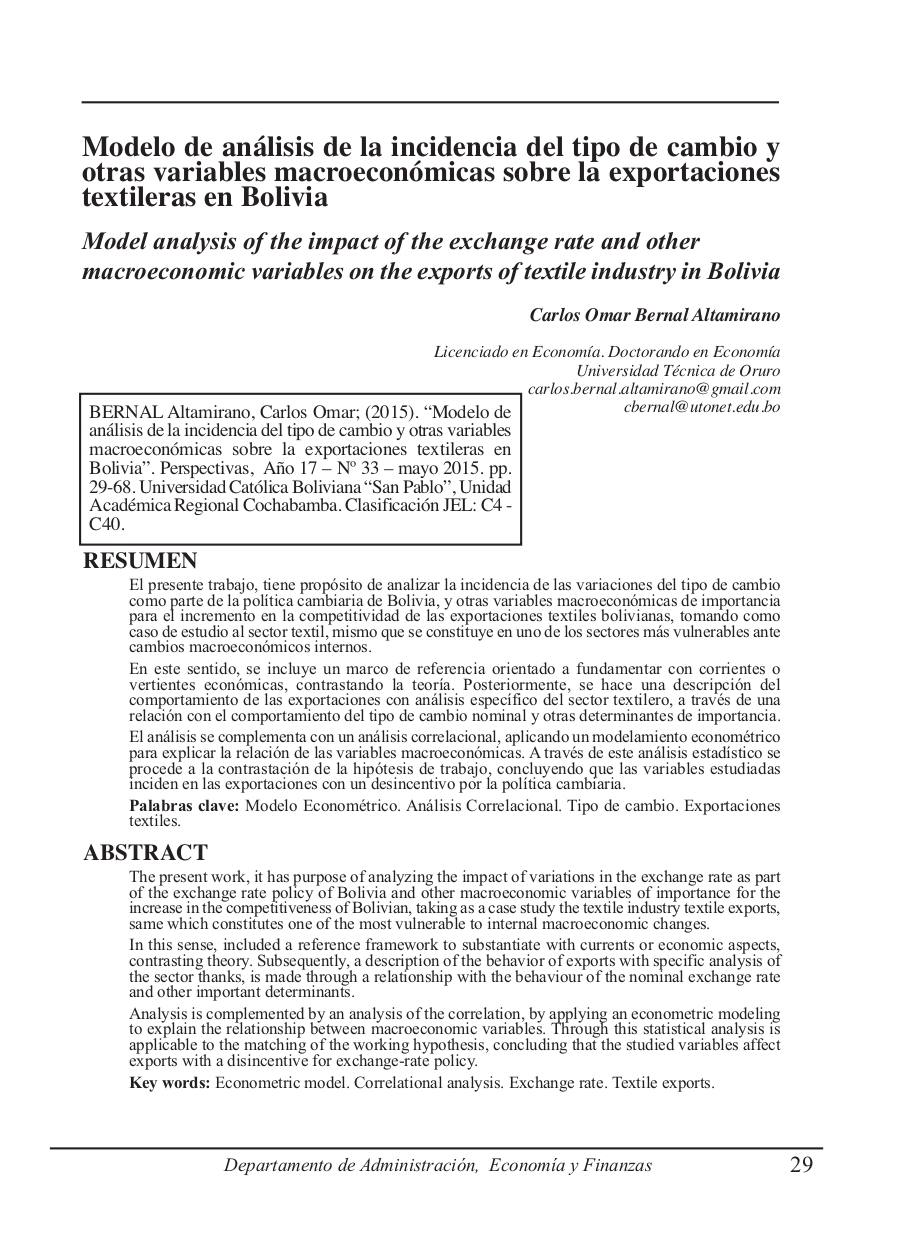Model analysis of the impact of the exchange rate and other macroeconomic variables on the exports of textile industry in BoliviaCarlos Omar Bernal Altamirano
DOI:
https://doi.org/10.35319/4dyjv365Keywords:
Econometric model, Correlational analysis, Exchange rate, Textile exportsAbstract
The present work, it has purpose of analyzing the impact of variations in the exchange rate as part of the exchange rate policy of Bolivia and other macroeconomic variables of importance for the increase in the competitiveness of Bolivian, taking as a case study the textile industry textile exports, same which constitutes one of the most vulnerable to internal macroeconomic changes.
In this sense, included a reference framework to substantiate with currents or economic aspects, contrasting theory. Subsequently, a description of the behavior of exports with specific analysis of the sector thanks, is made through a relationship with the behaviour of the nominal exchange rate and other important determinants.
Analysis is complemented by an analysis of the correlation, by applying an econometric modeling to explain the relationship between macroeconomic variables. Through this statistical analysis is applicable to the matching of the working hypothesis, concluding that the studied variables affect exports with a disincentive for exchange-rate policy.
Downloads
References
Chacholiades, Miltiades. (1998). Comercio Internacional. Editorial McGraw-Hill. México. (pp. 59).
El Mundo (2013). La Bolivianización podría perjudicar al sector exportador.
Fundación Milenio. (2009). Informe de Milenio sobre la Economía Boliviana. Konrad Adenauer Stiftung. Ed. Quipus. La Paz, Bolivia. (pp. 5-60).
Gónzales, J. (2000). Desarrollo del Comercio Internacional en el Siglo XX. Caracas- Venezuela. (pp. 45-58).
Gonzáles Martínez R.M. (2011). Riesgo Macroeconómico y Bolivianización: Un análisis de cointegración con un portafolio dinámico no estacionario de mínima varianza. Editorial BCB. Bolivia. (pp. 10-57).
Humérez Quiroz J., Yáñez Aguilar E. (2010). Desarrollo del Sistema Financiero y Crecimiento Económico. Una aproximación a partir del caso Boliviano: 2000-2009. Editorial BCB. Bolivia. (pp. 3-24).
Krugman, P., Obstfeld, M. (1999). Economía Internacional, Ed. McGraw-Hill/Interamericana S.A., 4ta ed., Madrid, España. (pp. 529-695).
Luna Acevedo B.A. (2011). La Apreciación del Tipo de Cambio y su Efecto en la Balanza Comercial. Caso boliviano (2006 - 2008). Editorial BCB. Bolivia. (pp. 35-55).
Muriel H.B. (2009). ¿Las Exportaciones fueron importantes para Explicar el Crecimiento Económico?. En Nueva Economía Nro. 33. La Paz, Bolivia. (pp. 4-6).
Ocampo J.A. (2011). Macroeconomía para el Desarrollo: Políticas Anticíclicas y Transformación Productiva. Interacción entre Macroeconomía y Desarrollo Productivo y el Papel Crítico del Tipo de Cambio. Revista CEPAL Nro. 104. Edit. CEPAL. (pp. 29-32).
Paez, J. (2004). La Economía Global. Editorial La Nación. México. (pp. 73).
Salvatore, D. (1997). Economía Internacional. Editorial McGraw-Hill/Interamericana S.A., 4ta Edición, Santafé de Bogotá, Colombia. (pp. 24-126).
Samuelson, P., Nordhaus, W. (2001). Macroeconomía. Edición 15.ª. Edit. McGraw-Hill. (pp. 4-56).

Downloads
Published
Issue
Section
License
Copyright (c) 2015 Revista Perspectivas

This work is licensed under a Creative Commons Attribution-NonCommercial-ShareAlike 4.0 International License.
La Revista Perspectivas de la Universidad Católica Boliviana, es una revista de acceso abierto, por lo tanto, es de libre acceso en su integridad. Está permitida su lectura, búsqueda, descarga, distribución y reutilización legal en cualquier tipo de soporte únicamente para fines no comerciales, siempre y cuando la obra sea debidamente citada.




